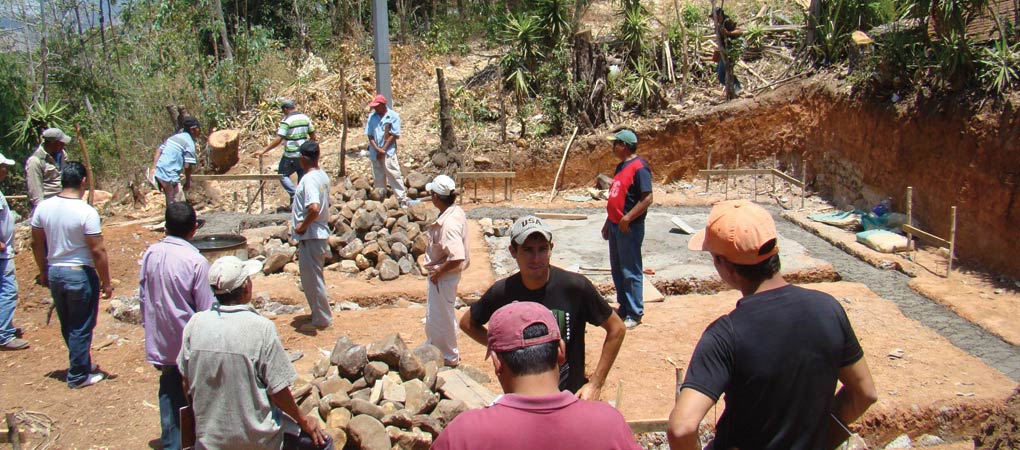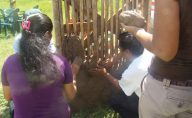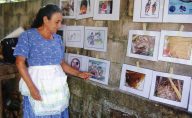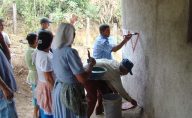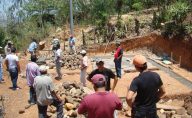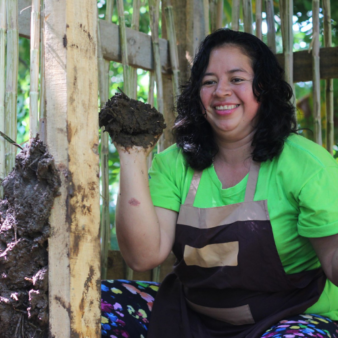A project led by FUNDASAL (the Salvadoran Foundation for Development and Low-cost Housing) to improve health and housing standards in the deprived rural settlements of canton El Pinalito in county Santa Ana, where the risk from disasters caused by natural phenomena such as earthquakes is high and services and infrastructure are poor. Supported by a wide partnership of organisations, the project has helped to significantly reduce the incidence of Chagas disease and other illnesses related to the poor condition of the habitat and has improved the durability of housing. Chagas disease is a tropical parasitic disease spread by insects that live in cracks and gaps found in poor quality housing, it is endemic to South and Central America. The objective of FUNDASAL and partners is to achieve a transferable model of intervention which will not require external funding, so the project embeds knowledge within the local communities and enables the use of locally sourced building materials. The inclusion and training of local households and support groups is integral to this project.
Project Description
What are its aims and objectives?
The project aims to contribute to the establishment of a replicable intervention model for the control of Chagas disease and reduced incidence of other illnesses, with the support of state institutions. It does so by tackling the physical and social vulnerabilities in canton El Pinalito in county Santa Ana, where the incidence of Chagas disease is highest.
What context does it operate in?
Many houses in El Salvador are self-built and not strong enough to withstand hazards or extreme natural phenomena such as earthquakes. Poor housing conditions and lack of support services enable the proliferation of insects that transmit Chagas, malaria, dengue, respiratory and gastrointestinal conditions and many other diseases.
Much of the local housing is built with earth and cracks in the structures harbour insects (such as the “beaked bug” that transmits Chagas disease). Around a quarter of people who contract Chagas disease develop cardiac problems which lead to heart failure. Other bugs are carried by animals that are allowed to sleep indoors.
Many households in the area do not have security of tenure due to legal issues regarding entitlement and ownership which cause complications regarding their ability to address problems with their homes.The local economy is heavily reliant on agriculture, so adjustments had to be made to the project’s implementation and engagement activities to accommodate the farming calendar, for example, when local people have to focus on crop harvesting.
Religious ceremonies are also highly important to local people, with similar adjustments being necessary to account for this.
What are its key features?
The principal objective of the project is to prevent diseases such as Chagas by tackling the underlying physical causes, especially poor housing, alongside awareness raising, education and social action (where other approaches have been mainly medical or educational only). Structural improvements were based on ideas first tested by the PUCP (Pontifical Catholic University of Peru) and then locally adapted through research in collaboration with the University of El Salvador and Japan International Cooperation Agency (JICA). The project also encourages sustainability and reduced costs through the use of local materials.
A participatory approach was used in establishing the project, to inform and empower the communities involved, regardless of gender or age. Planning was carried out with the input of local families, ADESCOs (community development organisations) and local training institutions.
The programme provides training across the breadth of the community being supported, through a variety of mechanisms. These include:
- Training for families.
- Training for young people via schools.
- Support for community development organisations to improve self-management skills.
- Training for health committees and inter-communal organisations.
- Practical and theoretical training in technical construction for fieldwork staff and families on the improvement and construction of housing and sanitation.
Practical interventions include:
- Physical intervention on housing and surroundings, for example, to cracked clay walls and floors, at the same time reinforcing walls to withstand earthquakes.
- Legal support regarding the human right to decent housing. Many of the project participants were settlers in the area but the legal structure of ownership entailed the land to others. FUNDASAL provided advice and explored a variety of legal mechanisms (such as bailment and inheritance law) to expand the number of families reached.
The intervention programme is supported by several key partners:
- The Ministry of Health, which supported the project by measuring the impact of changes to housing, contributing to the provision of training, monitoring the presence of disease-carrying insects and undertaking other measures of disease prevention in the target community, such as fumigation.
- The Ministry of Education, which made facilities available and integrated health issues into the curriculum, involving teachers and improving the physical condition of local schools.
- The Municipality of Santa Ana, which provided administrative support and contributed staff and other resources
- The Community Investment Committee of TELUS International El Salvador (TELUS is one of the largest telecommunications companies in Canada), which supported youth activities and awareness raising.
- Four community development associations (ADESCOs), which are legally recognised community-led groups committed to local improvement, training and development. These were ADESCOLME, ADESCOMAR, ADESCOES and ADESCO LA ESPERANZA.
How is it funded?
The project received financial support from a number of different organisations. These were:
- FUNDASAL (the Salvadoran Foundation for Development and Low-cost Housing).
- Manos Unidas (a Spanish NGO with a focus on reducing the effects of poverty through interventions in agriculture, health, education, social development and the advancement of women), which acted as the co-ordinator for the project and facilitated access to funding from five Spanish local or regional authorities. These were the Government of Cantabria; the City and Provincial Councils of Guadalajara; the Provincial Council of Valencia and the City Council of Pamplona.
- MISEREOR (the German Catholic Bishops’ Organisation for Development Cooperation, which supports the principle of help towards self-help).
- Two national awards (in the form of financial contributions) given by the Gloria de Kriete Foundation (based in El Salvador, which provides support to organisations committed to the well-being and improvement of Salvadorian families).
- TELUS International El Salvador (TELUS is one of the largest telecommunications companies in Canada).
The programme was carried out over two main phases and four interphases. The total cost was US$1,464,851.21. Donor contributions paid for staff, building works, transportation, training, equipment and materials and various facilities. Communities contributed labour and local authorities provided new and existing staff to collaborate with the programme.
The project also benefited from a number of non-financial donations such as training and support from a range of partners.
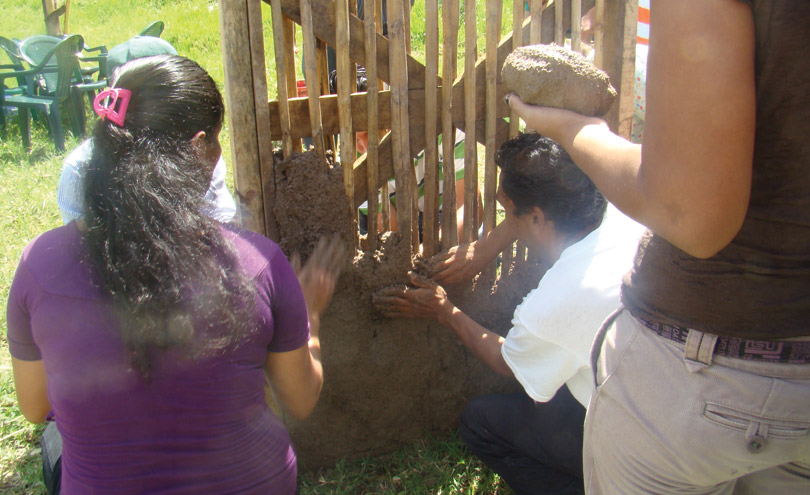
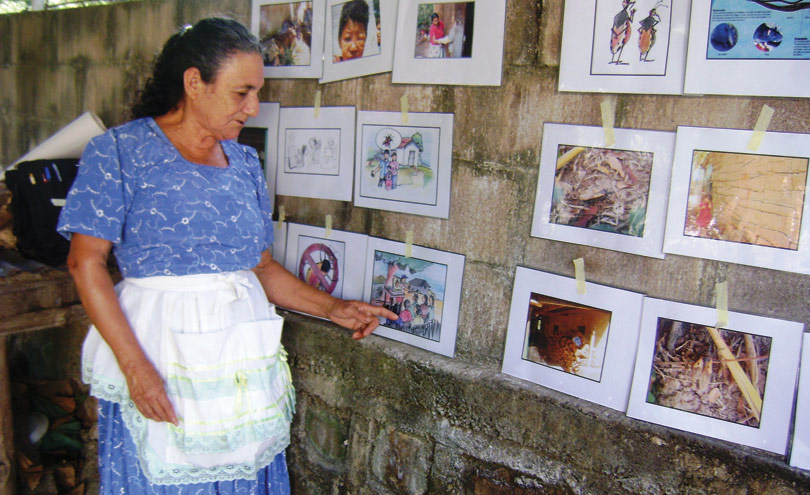
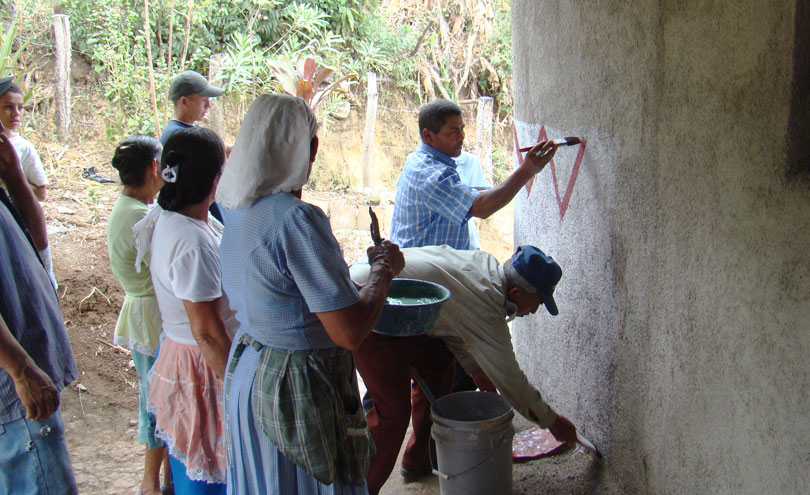
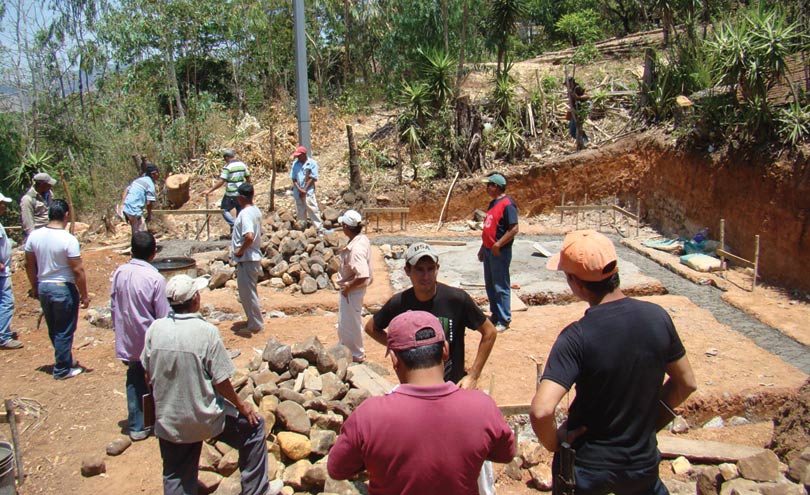
What impact has it had?
The project has benefited over 300 impoverished and excluded families in ten rural settlements with no access to adequate housing or public or private programmes. It has helped to strengthen community cohesion; rather than acting individually, people now have learned to address problems together. The training provided has helped to embed improved health behaviour and increase the quality of housing, as well as putting in place institutional support from permanent institutions like the health service.
Local communities have been empowered to improve their own situation through:
- Greater awareness and knowledge about various diseases and what causes them, leading to changes in behaviour. Two major hygiene surveys involving hundreds of families have shown a huge increase in awareness of Chagas disease and its causes and in hygiene behaviour and a reduction in presence of the bug.
- Training in self-applied improvements to homes and services (sanitation, kitchen) which benefits their health and safety and raises living standards.
- Increased community cohesion and joint problem-solving.
- Establishment of an umbrella organisation which now represents and advocates for the communities on a wider scale.
- A strengthened role for women, both in project implementation and taking a lead.
Neighbouring communities have observed and learned from the Pinalito experience and started to copy some of the techniques, sometimes assisted by Pinalito residents. The health promoter, recruited by the Ministry of Health, is also helping to transfer the experience to neighbouring communities. At least two communities have come to visit to learn from the project.
A National Network against Chagas disease has been formed, which aims to generate greater awareness and action. The initiative is also used as a model by the University of El Salvador to influence other municipalities.
The project was awarded the “Helping those who help” prize by the Gloria de Kriete Foundation in 2011 and 2012. FUNDASAL was also asked to present the project experience at three events: the First National Chagas Conference in El Salvador, the Manos Unidas Forum in Cadiz, Spain and the Terra 2012 Conference in Lima, Peru. Replica projects have been formulated for two areas of the country and presented to the Inter-American Development Bank and the Vice Ministry of Housing and Urban Development.
The Research Centre of the University of El Salvador has shared knowledge from the project with other municipalities where there is a high rate of Chagas disease. As a result, the town of Tacachico has prepared a Chagas project. In addition, the community of Matapalos in Honduras has been trained and is currently implementing the intervention model.
Why is it innovative?
- The principal innovation by this project, in the context of El Salvador, is in preventing diseases such as Chagas by tackling underlying physical causes, especially poor housing alongside awareness raising, education and social action, where other approaches have been mainly medical or educational only. Structural improvements were based on ideas first tested by the PUCP in Peru, then locally adapted through research in collaboration with a university of El Salvador.
- The use of mainly local materials in strengthening and improving houses.
- A joined-up approach between communities, the NGOs, schools and government agencies of health and education.
- Education across all groups in society, regardless of gender or age.
- Alternative ways of creating sufficient tenure security to avoid evictions and enable home improvements.
What is the environmental impact?
The project mainly uses local materials including earth, wood, bamboo and thatch. This keeps the transport component – and related energy need – down. The building materials required are simple and predominantly recyclable. The project also recommends that bamboo is replanted to encourage sustainability.
The compost toilets introduced are designed to save water and produce a source of fertiliser with secondary benefits. The stoves introduced reduce smoke in kitchens – a health benefit – and are more fuel-efficient than the stoves previously used. The project has also improved the means of waste disposal and protection of water resources such as springs.
Is it financially sustainable?
The project set out to define and prove a replicable model of tackling Chagas and other diseases. If it succeeds in doing so, no future funding will be needed for similar projects by FUNDASAL, though it may still want to raise funds to promote replication.
The project was not primarily designed to generate local incomes. However, people’s assets in housing and services and therefore their wealth, have definitely increased. The emphasis on using local materials also keeps transport costs down, which saves money.The costs of home improvements are kept low by using mainly local materials and skills. By empowering residents in this way, better and safer housing, as well as related services, have become much more accessible.
What is the social impact?
The project has improved community engagement and strengthened the organisations representing local people (ADESCOs). This has led to inter-communal action on health. The educational aspects of the project have successfully brought about behavioural change.
The most vulnerable and excluded were targeted for housing improvements and inclusion was actively promoted (for example the participation of women in social and construction processes; the education of all irrespective of gender and age; linkages and collaboration between Community Based Organisations and state agencies). A particular effort was made to reach young people, thus raising awareness and creating skills at an early age.
Barriers
- People lacked belief in institutions, because they had been let down twice by other agencies before. Thus, time was required to establish credibility and trust.
- Agricultural and religious calendars are important to people, and the project had to adjust the timing of its activities to those.
- Some people were not interested in the project because they already had good housing, or did not see its need. Many others were unaware of the presence and risks of Chagas and other diseases, and therefore taking action against those was not a priority to them. Thus, the project needed to spend time on raising awareness.
- It was found that many households did not have secure tenure, preventing their participating; thanks to flexibility of the main donor, this was tackled, and at least some form of guarantee established to improve security.
- The lessons of the project have been analysed and are being made available as an example for others to replicate; the project is aware, though, that local contexts differ, and the model offered therefore may have to be adapted to each situation.
Lessons Learned
- The project has helped to strengthen community cohesion; rather than acting individually, people now have learned to address problems as a community.
- Households face several vulnerabilities, of which exposure to disease and natural disasters is one. But e.g. land tenure is also insecure and should be integrated in such projects from the onset.
- The project could also have integrated medical interventions more closely, alongside the physical ones addressed by FUNDASAL. This would have required closer collaboration with other agencies charged with health issues.
- It is essential to formulate any collaboration into formal agreements, to ensure their continuity.
- The success of projects like this lies primarily in the capabilities it leaves with families to change their health behaviour and maintain their houses well, with some institutional support of permanent institutions like the health service.
Evaluation
The established health committees extensively monitor families’ hygiene habits twice yearly, with FUNDASAL’s monitoring unit, thus establishing sources of contamination and any illnesses. In addition, the Health Service of Santa Ana carries out vector monitoring on bugs collected, and thus continues to maintain vector control. It is also undertaking a pre- and post-intervention evaluation of the FUNDASAL project in order to initiate a process of Chagas disease prevention. There have been two major hygiene surveys, of hundreds of families, showing a huge increase in awareness of Chagas disease and its causes and in hygiene behaviour, and reduction in presence of the bug. The project has been externally evaluated.
Transfer
Replica projects have been formulated for two areas of the country and presented to the Inter American Development Bank and the Vice Ministry of Housing and Urban Development. They are awaiting review and approval.
Neighbouring communities have observed and learned from the Pinalito experience and started to copy some of the techniques, sometimes assisted by Pinalito residents. The health promoter, recruited by the Ministry of Health, is also helping to transfer the experience to neighbouring communities. At least two communities have come to visit to learn from the project.
The project has become a model used by the Research Centre of the University of El Salvador to present to other municipalities with a high rate of Chagas disease. As a result, the town of Tacachico has prepared a Chagas project.
The community of Matapalos in Honduras has been trained and is currently implementing the intervention model.

